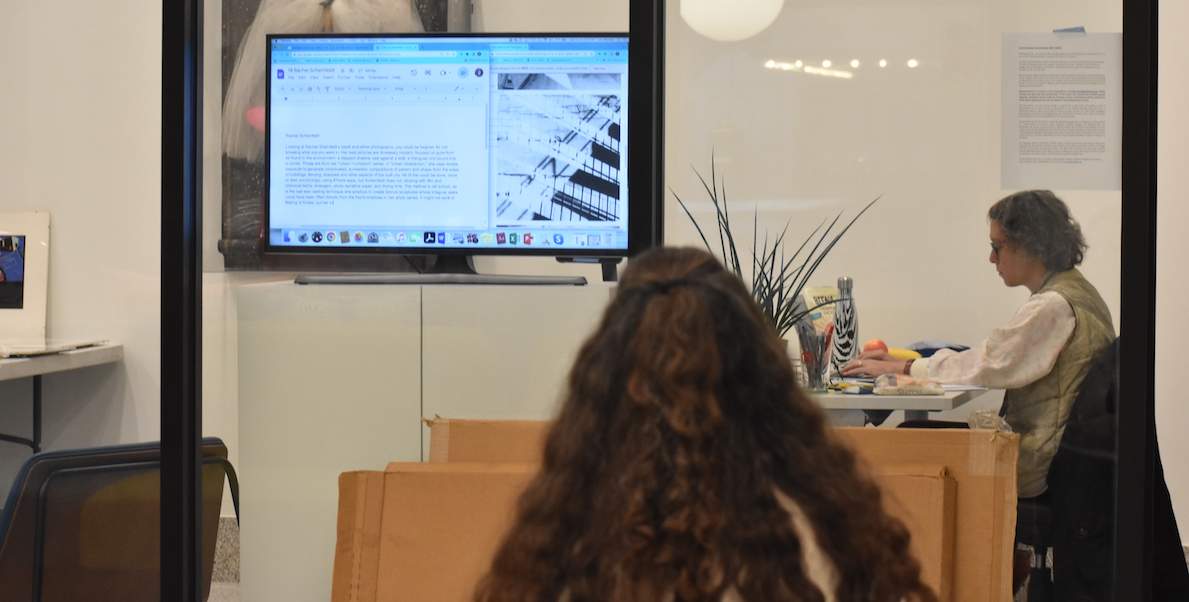For three days this past week, I sat in a glass-walled gallery in Gershman Hall, University of the Arts, writing reviews for any and all artists who asked. Some of them stuck around to watch me do it; others did not. I have done this a few times a year almost every year since 2005, minus the pandemic, traveling around the country and occasionally across the ocean, to places where there are lots of artists but fewer and fewer critics to respond to it all. The 60 wrd/min art critic has been to Knoxville, Tennessee; Portland, Maine; Kassel, Germany; and many places in between.
In Philadelphia, artists of all stripes visited me during the performance, among them urban landscape painters, conceptual textile artists, old-school modernists, and experimental self-portraitists. Regardless of their age, identity, training or vocation, all of them make art and all wanted written, serious feedback from a professional critic. I am that and have been for the past two decades, most prominently for the Chicago Tribune, more recently for Hyperallergic. Normally I opine about what I believe to be the most exciting exhibitions up in Chicagoland galleries and museums. In Philly, it was the artists themselves who sought me out and decided what I would look at, and I did my best to respond thoughtfully to their work. Art criticism is a crucial part of a healthy art ecosystem, and here are 29 recent contributions to it, in chronological order of their writing.
01 JULIA MARSH
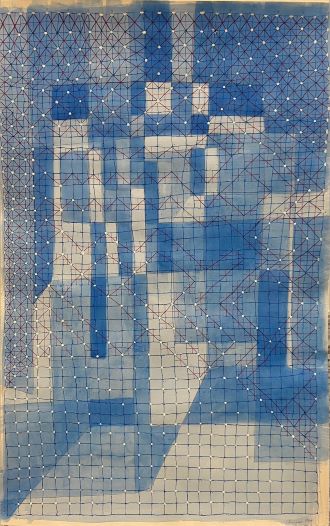
Parallelograms in different shades of blue gouache fill the background of Julia Marsh’s “Chicago Ave.,” underneath a grid of dark lines, joined by white dots and some red and pink intersecting segments. It seems like a pattern, something regular that happens over and over again, and it is, though with unpredictable and chaotic segments, where even the most careful viewer cannot know what will appear next. The drawing on paper belongs to “The Breach,” a series Marsh began in 2017 and which is based on her memory of places in which she experienced trauma. Shapes and patterns emerge from the past, connected to the physical layout of those spaces and the designs of wallpaper or clothing encountered therein; Marsh draws and redraws those figments, eventually coalescing them into compositions whose beauty is a startling rejoinder to the injury they represent. Personal life can be incredibly messy and difficult. How wise Marsh is, to process it through an aesthetic system of her own invention, thereby taking charge of past situations that originally took charge of her. The delicacy and focus enacted by her method enacts a kind of making — and looking — that blocks out everything else.
10/13/2023 12:17 PM
02 MARGARET MONTGOMERY
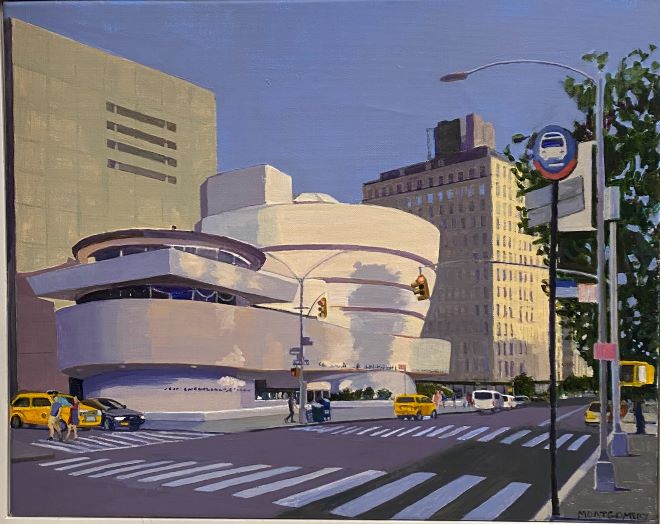
Cities are loud and busy but not at all hours — and not in all paintings. Margaret Montgomery, who grew up in New York City and takes it as the subject for many of her realistic paintings, does not depict a city of 24/7 noise and traffic and neon. Her Guggenheim glows with rosy sunset light, peacefully settled on an unusually calm Fifth Avenue. Her Jefferson Market Library sits likewise, quietly restful at the sharp corner of Sixth Avenue and West 10th Street. Even the pedestrians and cyclists are still. The details of surrounding buildings ring true to those landmarks as I remember them, from back when I lived there, too. I cannot say the same for City College’s Neo-Gothic Shepard Hall on its East Harlem campus, because I never visited but also because Montgomery paints it generically. I’ve also never been to the intersection she depicts in “Early Morning in South Philly,” but I could look at it for a long time, entranced by the urban hush, so silent yet so filled with the zig-zagging of utility lines across the pale blue sky and the awnings, buildings and stacked fruits whose colors and shapes rhyme through the streets.
10/13/2023 12:49 PM
03 WALLACE CAVANAUGH
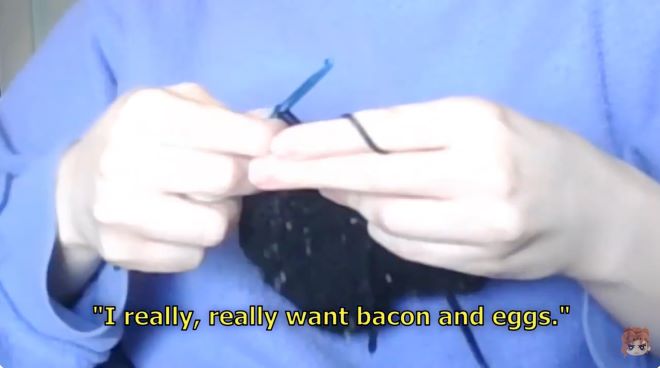
Many are the authorities at whose mercy we live: corporate, medical, digital, governmental. The phrase misleads, because there is no mercy there, as explored by Wallace Cavanaugh. The video “Joe wants eggs” tells the story of Cavanaugh’s great-uncle Joe, whose terminal cancer was most likely caused by X-rays Joe’s mother, Cavanaugh’s great-grandmother, underwent while sick with pneumonia during her pregnancy. In “You’re killing us,” a video collage, connections are drawn between the opioid crisis, as manufactured by Purdue Pharma, and Superfund sites throughout the country. “Sovereignty and the Body” creates imitation Polaroids of individuals captured — often unknowingly, always non-consensually — by Google Earth as it passed them by, on its journey to survey every street the world over. In the face of such immense, intractable systems, most of us just throw up our hands. Cavanaugh, instead, uses their hands to enact care: crocheting a frying pan of bacon and eggs while Joe’s story is being told (it’s a meal he wished for and was denied, an incident that has long haunted Cavanaugh’s grandmother); noticing those anonymous souls on Google Earth and giving them their due.
10/13/2023 1:26 PM
04 JENNIFER BAKER
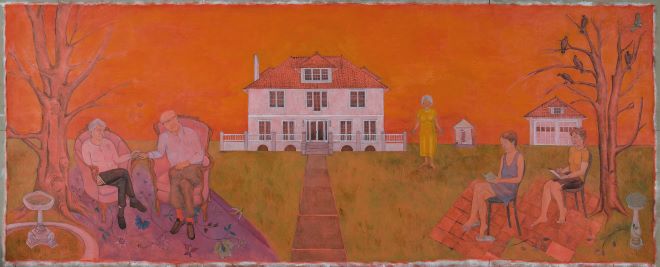
How do we remember people and places once they have been lost? You can go for a walk through a neighborhood with someone who has long lived there, and they can tell you, oh, this used to be here, that used to be there. You can look through photo albums with family, and they can tell you stories about the dearly departed people in the pictures. Or you can do what Jennifer Baker has done, which is to draw, paint and print your most important surroundings — your neighborhood, your parents — during times of transition. Northern Liberties has undergone intense transformation during the 30 years Baker has kept a studio in the neighborhood, in an 1892 former textile factory, changes that have happened are not always visible at street level. But their traces are etched permanently in works like “Crane,” a miasmic oil on mylar that depicts the convergence of construction and destruction, and “Third Street,” an 18-foot-long panorama that does much the same, though under sunset colors and with endless narrative detail. Equally epic, though far more personal, is “Elegy” and the many smaller works related to it, some of which act as studies for the people and scenes depicted therein. Two of these people are Baker’s parents, with whom she quarantined during the pandemic, and who both ultimately died from Covid. Her tribute to them glows orange and is filled with more tenderness, detail and balance than normally fit onto a canvas, no matter how large.
10/13/2023 2:01 PM
05 ERIN ELMAN
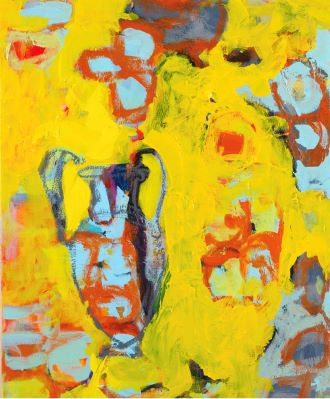
The still life is one of the great categories of painting, and usually it is quite well behaved: food is artfully arranged, objects of symbolic significance carefully displayed, choice flowers propped up in vessels. By definition, nothing moves. Still life, get it? Not so four recent examples of the form painted by Erin Elman, and which owe something to the radical French painters of interior scenes: Vuillard, Bonnard, Cézanne. Though modestly sized and composed like any other out of acrylic medium, Elman’s pictures do not comport themselves with any propriety, refusing to illustrate their subjects as solid things that stay in place. The flora are particularly rambunctious, spilling out of their containers and filling their compositions with cascades of sunflower yellow and sky blue, roundels of magenta, tendrils of pink. The vessels meant to contain them never stood a chance, drawn as translucent items with forest green outlines and pale pink marks — of course their contents would overflow and proliferate. And thank goodness for that.
10/13/2023 2:33 PM
06 KATHLEEN CATANESE
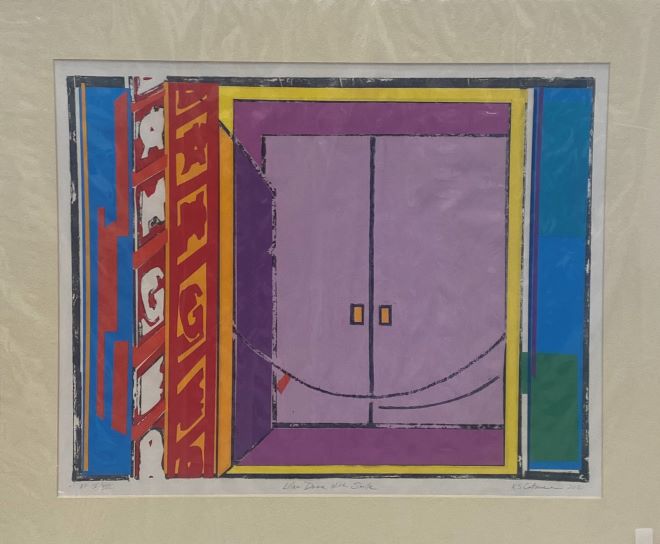
The urban world is made up of shapes and colors. Just look, you’ll see them eventually. If not, there’s always the art of Kathleen Catanese to help you out. Working from images she takes with her phone, she proceeds to charcoal sketches, and from there to watercolors and eventually oil on canvas. But it’s her city scenes printed in dark gray, with brilliant tones stuck on using the chine collé technique — in which thin paper shapes are adhered to a ground during the printing process — that truly make a modernist artwork of downtown. The roped-off nightclub entryway in “Lilac Door with Smile No. 5” has the catenary of a late Jasper Johns and the overlapping rectangular color play of Josef Albers. “The Hot Pink Ladder No 15,” with its acid green sky, magenta foreground building and faded black silhouettes, features a Warhol palette and begs to be repeated, in any number of different hues. The city begets modern art, and the city is modern art.
10/13/2023 3:59
07 JESSICA ELDREDGE
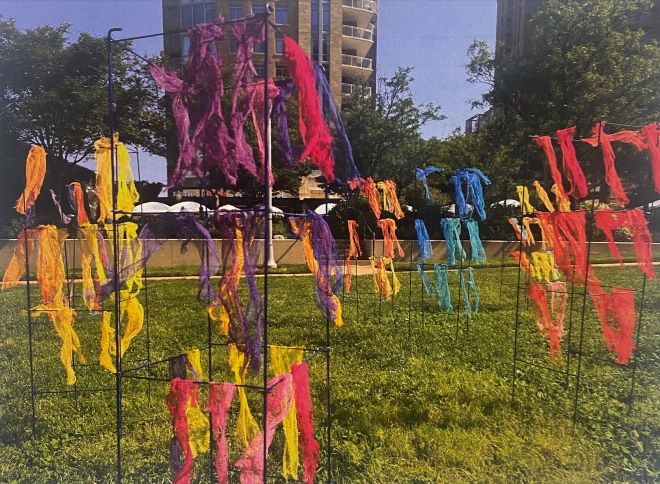
What to do with all of the stuff panic-bought during the pandemic? Toilet paper was obvious, but Jessica Eldredge purchased rolls and rolls of cotton gauze. When it proved thankfully unneeded, she dyed it brilliant shades of yellow, ochre, pink, blue and turquoise, and used the resulting materials to create two distinct artworks. Installed outdoors last May at the Tephra ICA Arts Festival, “Infinite Prayer” flew hundreds of pieces of gauze from dark blue metal cages, similar to those used in gardens, for a festive, memorial effect akin to that achieved by Tibetan prayer flags and papel picado, the colorful cut-paper banners hung on Día de los Muertos. “Mirror in Mirror” is something of its opposite, a series of prints made by pressing one piece of dyed cloth between two pieces of paper. The resulting images glow with unexpected liveliness, each a bright ghost, tenderly and precisely portrayed.
10/13/2023 4:28 PM
08 ANH LY
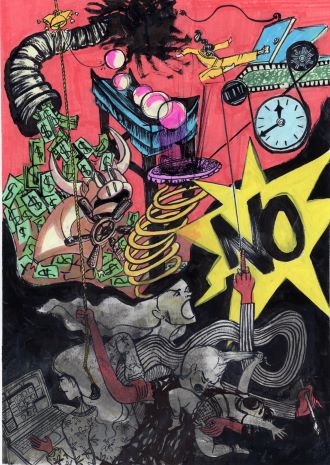
Anh Ly has many difficult tales to tell, based on her densely-markered drawings of people living through the scourge of online child sexual exploitation. These are complicated, messy compositions, hard to look at, challenging to make sense of, and totally clear in their nightmarish implications. But Ly has plenty of other styles and subjects, too, from Vietnamese food (tastily illustrated with clever stylization) to rebels living underground in the jungle (think storybook cut-away section) to the numbers 1-9 (as expressed by a very flexible nude woman). One especially winning series features a bevy of geishas, all sharp lines and sinuous curves, playing baseball, doing backflips, flying a skateboard, pumping big iron, ice skating a spread eagle, and scaling a climbing wall, all while sporting kimonos, obis and those Geiko Shimada wigs. Tokyo Olympics 2032?
10/13/2023 4:56 PM
09 MICHELLE MARCUSE
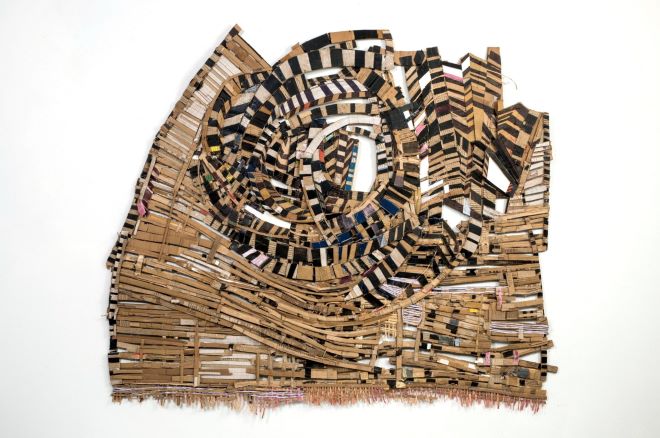
It’s hard to say if the sculptures of Michelle Marcuse are finished. “Mapburst” reconfigures strips of painted cardboard into a giant whorl atop horizontal waves, looking as if it has only momentarily settled into its current shape. “Body blend” wraps string back and forth between two curvy wires, as if draping a model with fabric while creating a new garment or, less fancifully, as if some poor waif were dressed in rags on the way to dissolution. Marcuse’s materials, which also often include raffia and shreds of paper, must be broken down in order to be remade anew, and their colors rarely stray from black, brown and white, though yellow wire coating can be glimpsed underneath a scrappy coat of dark paint in “Raising the twilight.” It’s a process, and arguably a result, fitting for an artist born in apartheid South Africa, who has grown up watching her country pull itself apart and put itself back together, over and over again.
10/13/2023 5:26 PM
10 ELLIS ROSENBERG
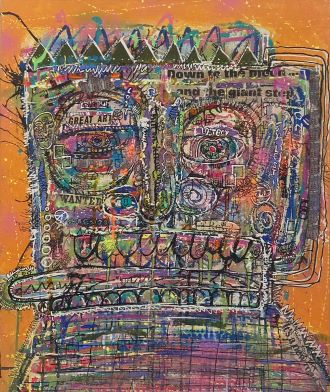
Doodles are usually small things found in margins. But what if you took a magnifying lens and blew up a doodle, what would you see? A trio of paintings by Ellis Rosenberg posit one possible answer to this question: Doodles are made up of other doodles, endlessly, rhizomatically, getting smaller and smaller until there’s simply no space left. What kind of doodles? “Man with Teeth,” a cacophonic, riotous, Basquiat-esque dude as compact as he is electric, comprises heads and scribbles and eyeballs and shapes, plus choice phrases, some of them expertly collaged from newspaper headlines and others featuring Route 66 signage. “Zeitgeist of the Streets” thoroughly inscribes, on the red negative space of a recovered metal stop sign, white peace symbols, yin-yangs, spiderwebs and skulls, plus two sets of stylized eyes and nose in gold. Perhaps the right question to ask is who’s made up of doodles. As for what a doodle’s made of, I’m betting on an artist’s unconscious, at least that’s what always happens to me when I’ve got a pen and blank space available.
10/13/2023 5:52 PM
11 SIRI LANGONE
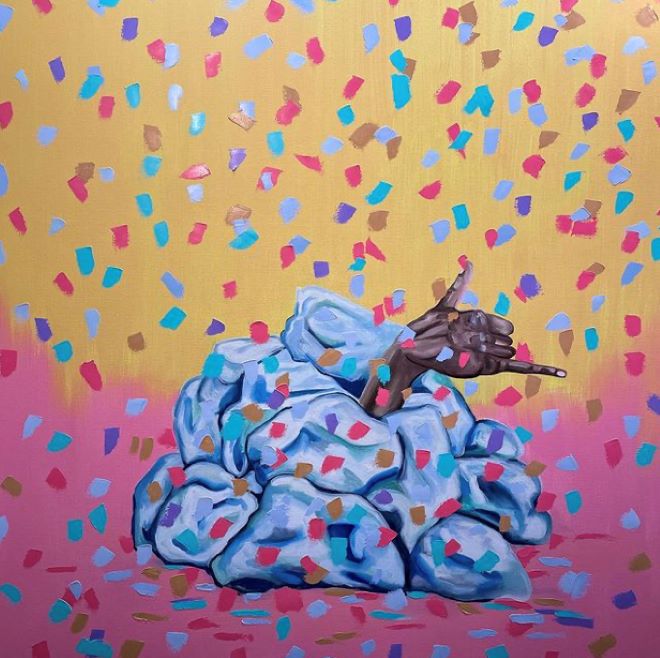
Colorful confetti! Giant palm fronds! Rainbow fish and long-necked egrets! Siri Langone’s recent oil paintings present lovely scenes, until you realize they don’t. The sexy odalisque of “pleasant valley girl,” posed atop a fallen tree trunk in an animal-print thong and little else, is giving you the finger. The dude in “too soon for honey,” fishing off a rock, pants rolled up to his knees, has caught a dead swan. The person sitting at a table in “coffee & cigarettes v” seems to be enjoying their morning joe in a nice, mint green café, except their drink is violently sloshing out of its mug and their head is engulfed in smoke, source unknown. Curiously, the weirder Longone’s paintings get, the prettier they appear. “Call me,” the most charming of five paintings on view in the artist’s solo exhibition at University of the Arts’ Gallery 6, is strewn with thick pastel and gold confetti, filled with a happy yellow and pink background, and centered on a rock pile out of which extends a hand, two of its fingers making the titular sign. That’s contemporary life for you: Looks like a party but hides desperation and death.
10/14/2023 12:22 PM
12 ANDREA KRUPP
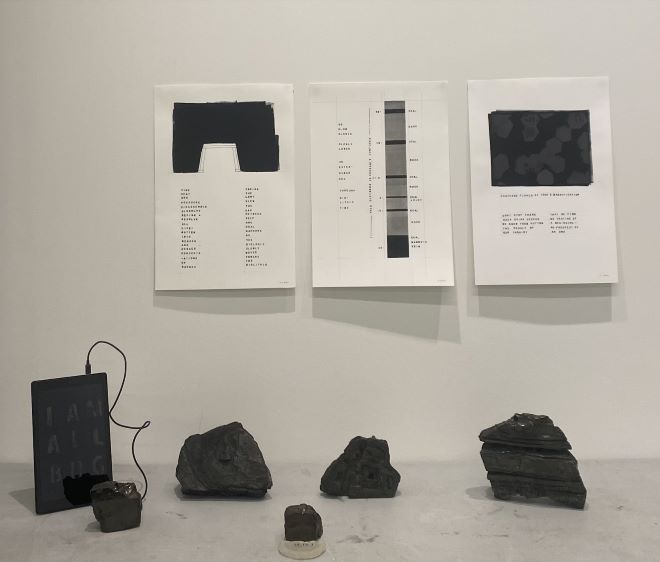
Chemically speaking, anthracite lies halfway between ordinary bituminous coal and the graphite found in pencils. It has high carbon content, few impurities, and a dense blackness that can be polished to a sheen. As if that were not enough to make it a compelling artistic focus for Andrea Krupp, the world’s largest known deposits lie in northeastern Pennsylvania, her home state. What she takes anthracite for is both material and subject: shaping it into witty sculptures like “I am all bog,” its titular message muddily painted on a dark iPad screen, whose ostensible power source is the shiny chunk of coal to which it is connected by USB cable. The carefully carved “Room and pillar mine” features a hollowed-out strata of open caves, turning a block of anthracite into a miniature architectural wonder. A series of works on paper feature deep black pigment derived from anthracite and text-image musings on the “gap between self and coal,” which, when understood through “biolithic time,” proves far narrower than expected.
10/14/2023 1:01 PM
13 ANESU NYAMUPINGIDZA
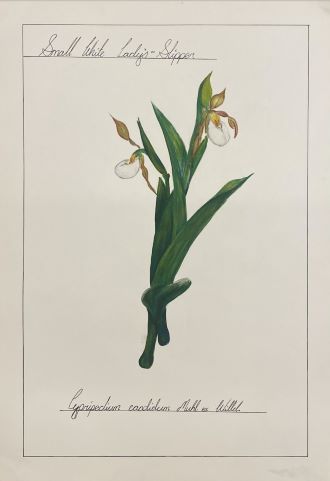
Go for a walk through a city park or down an alleyway with a knowledgeable botanist and you will be startled to learn of all the edible plants that grow, nay thrive, on their own in the most inhospitable of places. In Chicago, where I live, the bounty includes lamb’s quarters, staghorn sumac and purslane. In Philadelphia, where Zimbabwe-born Anesu Nyamupingidza resides, there is plenty more to discover, on the streets but also in her delicate, detailed botanical drawings. Her subjects include common butterwort, slender daylily, and wild flowers like the small lady slipper that have been extirpated in Pennsylvania. Also of concern are huitlacoche — corn fungus to some, corn smut to others — which Nyamupingidza explores in a didactic pamphlet that discusses food rights as a human right, one sorely needing implementation in U.S. food policy. One way of doing that is as Nyamupingidza suggests, by appreciating the devalued edible flora that already surround us, not least the acorns that lie on the ground, unwanted, ready to be boiled, roasted and candied according to a recipe she provides.
10/14/2023 1:34 PM
14 MONIKA LIN
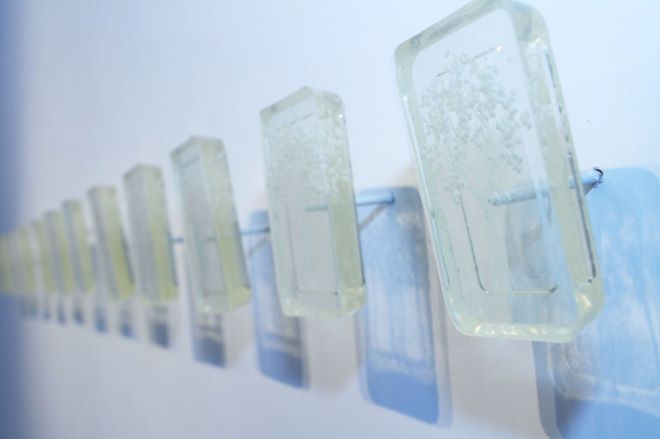
In “On Longing,” writer Susan Stewart explains the appeal of miniatures. It is a lesson well attended to by Monika Lin in many of her sculptures, from the tiny trees of “Take Away,” built of rice grains and masking tape fragments set into to go-container rectangles of resin, to the mix-and-match ceramic monster figurines of “Harvest” and the brooches of “Domestic Fabric,” woven from donated hair, lint and dog fur. Why the irresistibility of tiny things is relevant here is because Lin’s subjects are not always as attractive as their presentation. “Take Away” is inspired by China’s so-called rice economy of cheap labor sustained by cheap sustenance. “Harvest” plays with the present and future of genetic engineering and other mutations. “Domestic Fabric,” a take-off on Victorian mourning pins, fashions delicate wearable objects out of personal refuse. Make it small and render it beautifully, and we will not be able to resist engaging.
10/14/2023 2:08 PM
15 LISA DOMENIC
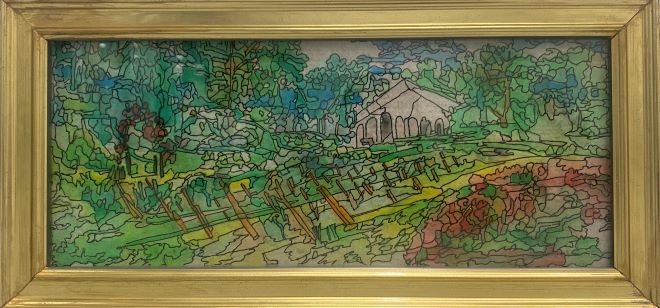
Certain tried-and-true techniques have the possibility of profound revelation. Lisa Domenic practices continuous line drawing, in which pen never leaves paper, and the results are compositions in which everything is connected and movement is ever-present. “Freedom to Glow,” a landscape of shimmery greens, joins together vines, trees, cloud-strewn sky and an American flag, as if all had sprung from the same root. “Pink” does likewise with a still life of roses in a glass vase, every leaf and petal intertwined and vibrant, related as well to the table on which it sits and the walls that form its background. This seems a statement not just about the liveliness and beauty of nature but about life in general, and the value of noticing the interconnectedness of all things. Also, they’d make stunning works of stained glass.
10/14/2023 2:30 PM
16 BETTY HEREDIA

Music cannot be seen, only heard and felt, so it’s never obvious how a visual artist might represent it. Photographs of musicians only ever go so far. Betty Heredia, working primarily with marker on bristol board, has evolved an invigorating style at once synesthetically connected to sound and illustrative of music-making in process. Created in real time at musical performances of all types, as well as while listening to recordings, her drawings fill the page with what seems at first like an impenetrable field of hues and marks — wild and fabulous, but what? Look closer and the figures of bassists, trumpeters and drummers coalesce, becoming the players of the music whose colorful vibrations fill the air around them, which is to say the entirety of the picture plane. That’s what some music looks like: acid green swoops, blue scribbles and orange scratches for a jazz set by Jeff Parker; thick hot pink lines, black swirls and sharp light blue strokes for one by Isaiah Collier. Close your eyes and listen, open them and see.
10/14/2023 3:59 PM
17 JUSTIN C. HENRY
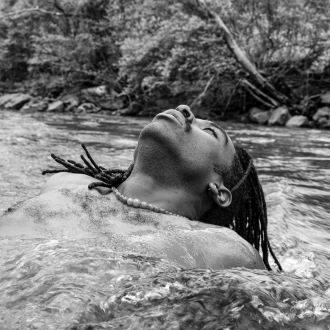
Our identities are deeply informed by the homes in which we grew up, by the people who raised us, by how we look, all without being exclusively defined by any one of those elements. The three friends Justin C. Henry follows in “Sojourn,” a short video, bear this out. They wander together and alone through town, hang out at home, play with young family members and pets, self-administer medicine. We see their bedrooms and living rooms and kitchens. A viewer, not actually knowing any of these kids, might make assumptions about them based on what is shown on screen, but because the video is presented as a two-channel piece, it’s clear no view is final, no conclusions complete. A person is always so much more than this, than that, than any one thing. In “Utopia,” an unrelated black-and-white photograph, a young Black man, possibly one of the friends from the video, lies back in a river, partially submerged, eyes closed in what can only be described as sheer bliss. A person is that, too.
10/14/23 4:37 PM
18 RACHEL SCHEINFELDT
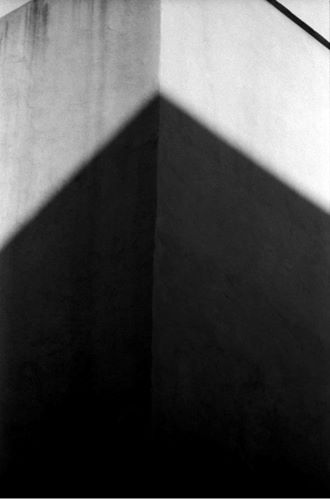
Looking at Rachel Scheinfeldt’s black-and-white photographs, you could be forgiven for not knowing what era you were in. Her best pictures are timelessly modern, focused on pure form as found in the environment: a stepped shadow cast against a wall, a triangular one bound into a corner. Those are from her “Urban Formalism” series. In “Urban Abstraction,” she uses double exposure to generate complicated, surrealistic compositions of pattern and shape by overlaying facades, fencing, shadows and other aspects of the built city. All of this could be done, more or less convincingly, using iPhone apps, but Scheinfeldt does not, sticking with film and chemical baths, enlargers, photo sensitive paper, and drying time. The method is old school, as is the lost-wax casting technique she employs to create bronze sculptures whose irregular slabs could have been lifted directly from the found shadows in her photographs. It might not work in hyper-contemporary cities like Beijing or Dubai, but her methods still feel right for a city like Philadelphia — or New York or Chicago, for the matter — cities that came of age in the 20th century, alongside modernist tools and aesthetics.
10/14/2023 5:10 PM
19 MILDRED ELFMAN GREENBERG
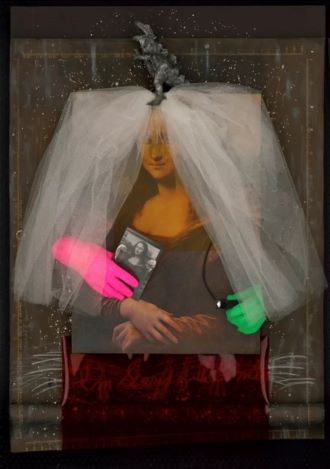
In 1986, Milly Greenberg wrote a letter to President Reagan, expressing her wish to be the first senior citizen astronaut. Her interest in space was not that of a layperson scientist or armchair explorer but a lifelong artist, one whose adventures took her through an entire century of artmaking. It’s hard to imagine that the same person who drafted the angular, high-modern public service announcements of her WPA years — when she was an easel artist with the Federal Art Project, earning $100 month in one of the most dignified programs ever run for artists in this country — would in the 1980s become the creator of assemblages like “I’m Scared of the Bomb (The Bride),” in which a veiled Mona Lisa, embraced by neon hands and crowned by a plastic dinosaur, poses against a shimmery night sky. But Greenberg was, if anything, a person who could embrace the possibilities available at any given moment, making art that was both entirely hers and entirely of its time, even as those times they kept a-changing, from her birth in 1912 until her death in 2003.
10/14/2023 5:54 PM
20 ANTONIA KIMBALL
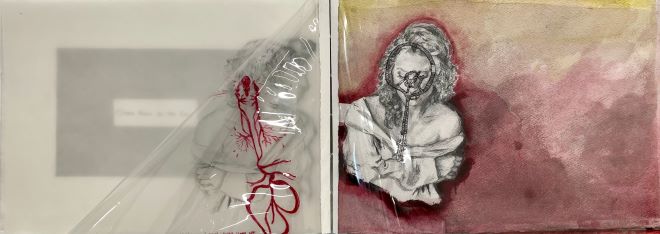
Since childhood I have loved transparencies in books, especially books about bodies. The layering of pages, the combination of visibility and hiddenness, has always felt particularly apt for visualizing what goes on underneath our skin, between our organs, behind our bones. With “Other Parts of the Body,” Antonia Kimball has made just such an artist’s book, encasing its pages gently inside cushioned baby blue cloth covers, as if she were laying it down on a bed, against a pillow, with tender care. It’s extraordinary what can be a page in a book: a painting on acetate of the vagus nerve, overlaid with anatomical correctness atop a classical pencil portrait of the artist, done on vellum. Blood red thread stitched into the lip of another pencil self-portrait, this one sketched against a moody watercolor backdrop. Plasticky handmade papers, splayed with tangled fibers and stains, peeking through a hole in the left frontal lobe of a third painted self-portrait, representing, according to a hand-written bookmark, the brain’s nervous system and unrepairable damage done to it. It can be incredibly difficult to sustain injury to one’s self, and remarkably healing to find unique ways of representing those changes, both for the self and to others.
10/15/2023 12:07 PM
21 PITTER PATTER STUDIO
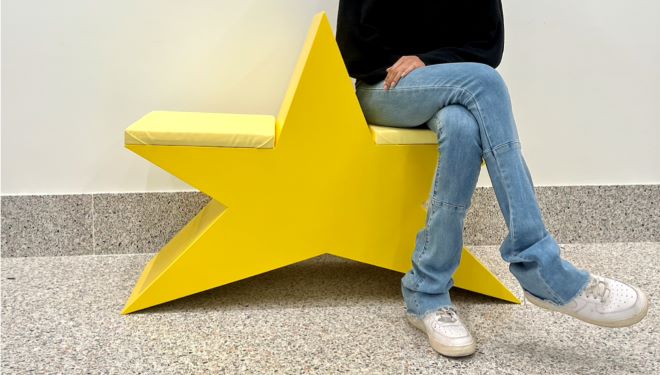
A delightfully spirited collaborative project of Yancey Ballard and Otoño Gaskins, Pitter Patter Studio produces handmade objects and furniture out of reclaimed wood, found stained glass, and whatever other materials they need. Their benches are a joy to sit on, especially the adorable “Star Chair,” a bright yellow two-seater with cushions placed back to back on the horizontal arms of a five-pointed aster. Perching atop it feels like being a star, not the celestial kind but the sort who tap-dances across a stage then rubs against a costar, legs and arms akimbo. Pitter Patter also carves candle holders in the shape of simplified people, with candlesticks popping out of their heads, faces whose natural wood grain becomes round cheeks and noses, and expressions that can only be described as, “Ahhh! My head is on fire!” Exactly what a candle holder with any sense ought to say.
10/15/2023 12:34 PM
22 ELIZABETH SHORES
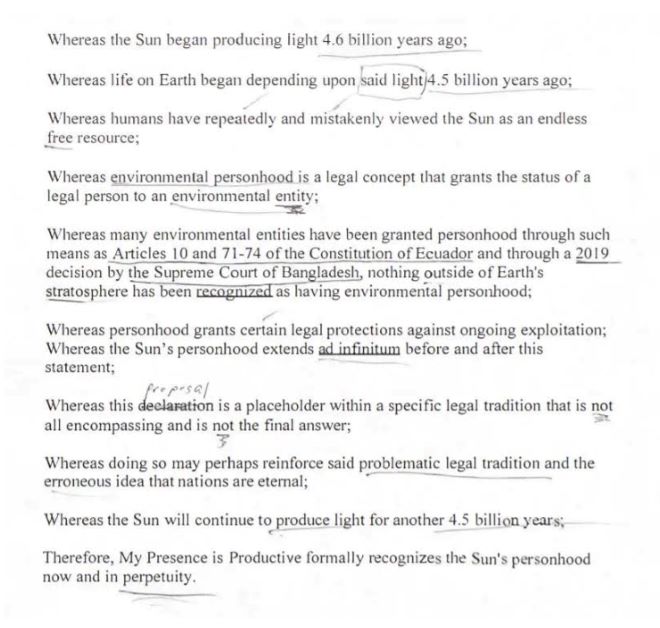
In order to protect the environment and its creatures from devastation, advocates must make use of national and international legal systems. The irony of this situation is profound, given that it is the prejudices and limitations of those same systems that have in many cases led to the degradation of the natural world. Conceptual artists like Elizabeth Shores are, surprisingly, quite well suited to working within such paradoxes, capable of seeing a million miles beyond them even while understanding their staid forms. And so, in an effort to safeguard natural resources, Shores became in 2015 the sole proprietor of My Presence is Productive, LLC, whose most recent declaration legally grants personhood to the sun. Why the sun, which has been around for 4.6 billion years and will continue to produce light for another 4.5 billion? Shores argues that it is one of the most perpetually exploited of resources. Now obviously the sun is not a person, but neither are corporations, and once upon a time neither were women or people of color. If human courts can’t understand rights except insofar as they are attached to personhood, then personhood is going to have to continue to stretch its definition, to the stratosphere and beyond.
10/15/2023 1:05 PM
23 IFE NII-OWOO
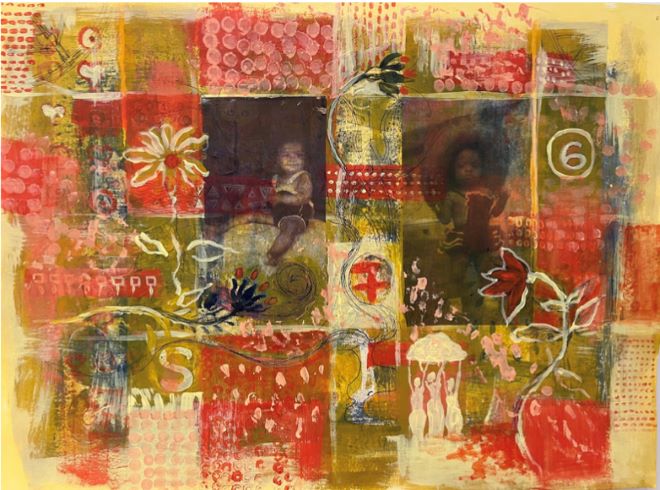
Life energy is not present in all works of art, but it is abundantly active in the paintings on paper of Ife Nii-Owoo. A pair read like quilts, though pieced together not from fabric swatches but painted squares of colorful patterns that alternate with family and other portrait photography, applied via transfer technique; Black Lives Matters slogans; illustrations of hibiscus flowers and other botanicals; and the Adinkra symbols of Ghana, where the artist studied in the late 1970s. As gridded and square as are these works, two others by Nii-Owoo are concentric and circular, expanding outwards from central figures, one of whom is masked. What emanates are lizards and leaves, spirals and dots and zigzags, in shades of blue and green, like the ocean and the forest. Everything in these pictures vibrates with noise and cascades in waves, never quite still or truly silent, like life.
10/15/2023 1:35 PM
24 THOMAS LAURIA
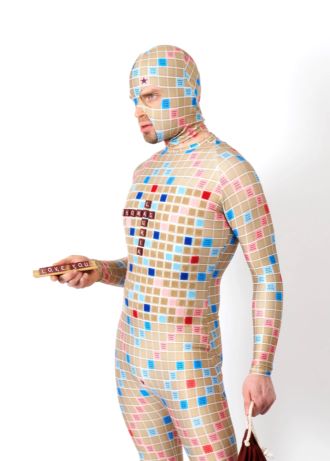
If I liked wearing body-revealing costumes, I would want Thomas Lauria to design one for me. In fact, he’s already made my fantasy garment: a head-to-toe bodysuit printed with a pattern created by scanning a 1970s Scrabble board, the same kind I learned on. The getup is interactive, playable with velcro-backed letter tiles that can be affixed to a chest grid. The full suit, which includes a mask, is also full-on fetishwear. Competitive verbiage is not a common fetish, though I guess it’s mine, and indeed the rest of Lauria’s designs hew more closely to the sexual norms of such gear. This includes a red latex devil suit, complete with inflatable tail and horns, created as a means of dealing playfully and daringly with a not-so-fabulous coming out experience to his conservative, religious family. Also available is “Scene Study,” a flashy latex suit complete with clear crotch panel, as if a superhero had been crossed with a porn star. Porn Man to the rescue!
10/15/2023 2:02 PM
25 SEAN STAROWITZ
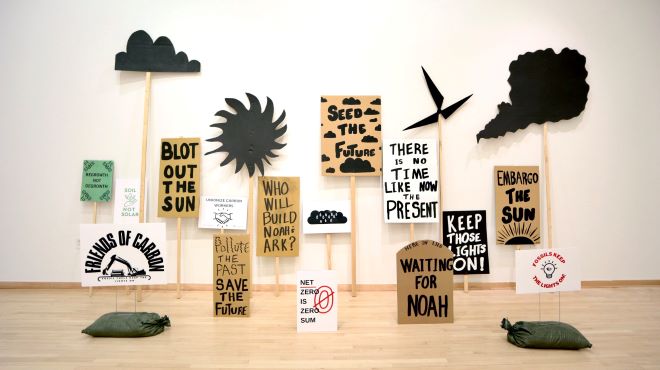
Why would anyone want to “embargo the sun?” It’s a slogan hand-painted on one of the many banners that comprise “Seed the Future,” an installation by Sean Starowitz that also includes printed lawn signs trumpeting the cause of a group called Friends of Carbon. (“Fossils keep the lights on” is one of their mottos.) No such group exists, of course, but Starowitz’s speculative protest signage is not so far from the arguments touted by the fossil fuel industry and the conservative governments and individuals who keep it running, and promise to continue doing so until there’s not much left — of life, that is, on this planet. What to do? Anything! Everything! And so Starowitz grows mushrooms on studio refuse, builds hemp bricks, and creates vast drawings of industrial energy and its end-times on paper using biochar, among other materials. “Waiting for Noah,” as one of his posters proclaims, is definitely not what he’s doing.
10/15/2023 2:38 PM
26 VIRGINIA MAKSYMOWICZ
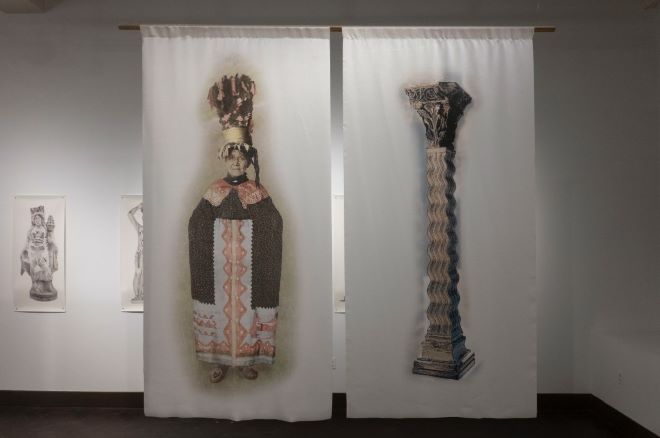
I had the pleasure a few summers ago of visiting the Acropolis for the first time. There I saw the famous Caryatids of Erechtheion, sculptures of women, carved from marble, that hold the porch roof of the Temple of Athena on their sturdy heads. I thought of them while looking at Virginia Maksymowicz’s “Comparisons,” long silk hangings on which are printed photographic images of architectural columns and of women. There are seven pairs in total, some hung side by side, others one in front of the other. The juxtapositions are formally compelling — a sphere finial column perfectly mirrors the silhouette of a Zuni girl balancing a water vessel atop her head; a wiggly column from the South of France echoes the patterns that run vertically up the robe of a Lenape elder. Like the columns, the women are strong enough to bear immense weight. Also like the columns, they are objects — objectified by men, by history, by the law, by art. This paradox, of female value being tied to female objectification, is as true as it is offensive, because the truth itself is so often offensive. This is well expressed in Maksymowicz’s “Comparisons,” as it is by the current reality of the Caryatids of Erechtheion: Due to pollution, the originals reside in the Acropolis Museum; due to colonialism, one of those is housed in the British Museum.
10/15/2023 4:07 PM
27 CHANTAL WESTBY
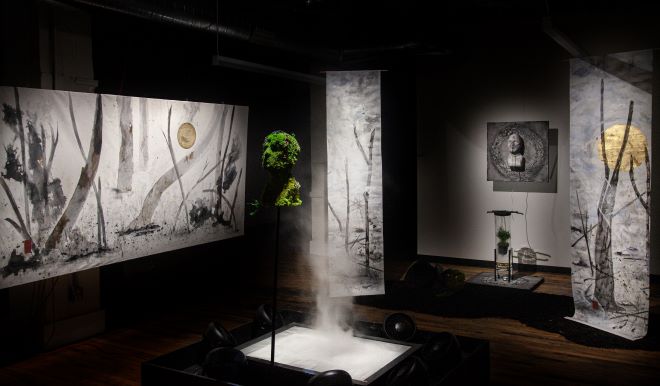
Is there a more urgent issue than climate change? The people of Ukraine and Gaza might argue otherwise, but taking the long view, climate change is it. An artist can take any number of approaches, from the conceptual to the representational and everything in between. Chantal Westby has chosen the sensual and immersive, creating a multimedia environment she calls “The Forest” with her collaborator Lénaïc Mercier. Among its elements are human forms, one covered in moss and seed pods, another gray and cracked, breathing through a face mask connected to a terrarium. These are speculative but opposite, and neither really bodes well for us: The former looks as we will if nature ever fully takes over, the latter if it doesn’t and we continue on our current path of world destruction. Surrounding these busts are beautiful landscapes done in the style of Japanese scrolls, with golden moons and towering vegetation, all rendered in fluid inky brushstrokes. Perhaps the Japanese masters had it right when they originated this style of artmaking, putting nature at the center and leaving people out of the composition entirely.
10/15/2023 4:42 PM
28 REBECCA LEDBETTER
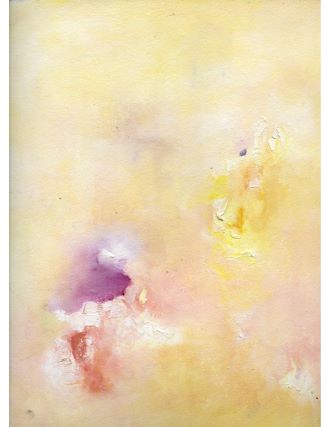
The amount of breath, air, light and energy contained in three abstract oil paintings by Rebecca Ledbetter is wondrous. Smooth from being done on sheets of paper, and cleverly framed with space between the compositions and their chunky wood frames, they are modest in size and enormous in effect. Imagine taking part of the background out of a pastel Lisa Yuskavage and you might be able to picture the shimmery, lush ephemerality of “The World Is Too Quiet.” Picture cutting a section from an early Philip Guston and you’ll get something like the lively chaos of “This Dream Within a Dream.” Put them both together, then take half of the arrangement out, and voila, from those depths emerges “A Deeply Hidden and Inarticulate Desire.” Oh, and turn that one sideways, because you can.
10/15/2023 5:26 PM
29 ZOE COHEN
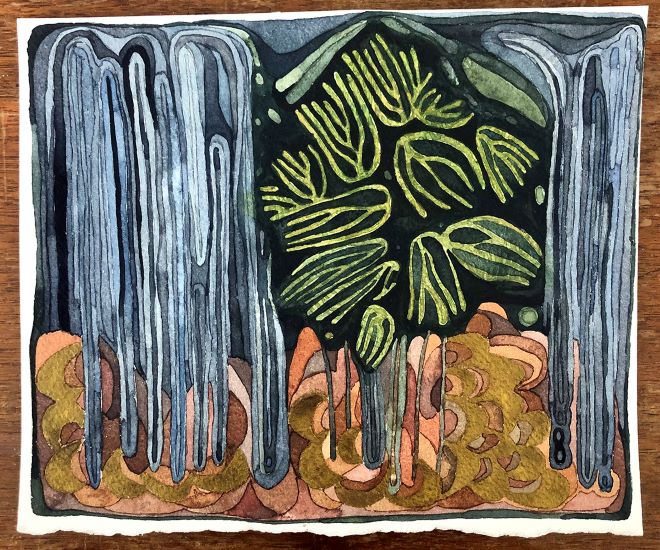
The worlds we humans can just barely see are some of the most wondrous: the underwater realm, the microscopic and molecular, the galactic. Artists have long known this, especially the Surrealists, many of whom were keen observers — and borrowers — of contemporaneous scientific imagery, especially as it developed to include coral reefs and the cosmos. Zoe Cohen’s latest watercolors depict dense tangles of organic matter in shades ranging from muddy brown and swampy green through cool blues and moody lilacs. Patterns and shapes emerge and are almost but not totally recognizable: not quite coral, sort of foliage, maybe seashells. The effect is dizzying and marvelous, grounded in the real but surmounting it with something that can be felt only by those who are open to it. For folks needing a little help, the inclusion of shimmery gold paint and, in the case of “Golem Eyes,” a pair of mysterious peepers, offers a nudge in the right direction.
10/15/2023 6:01 PM
![]() MORE ON THE ARTS FROM THE CITIZEN
MORE ON THE ARTS FROM THE CITIZEN



